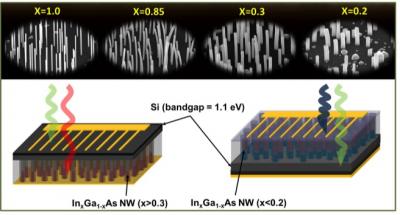Researchers at University of Illinois claim that miniature nanowires can aid engineers in producing high-performance photovoltaic cells and other electronic devices. Xiuling Li, electrical and computer engineering professor at the university, leads the research group.
The team has developed a new technique for integration of semiconductor nanowires on to silicon wafers. The results of the study have been published in the Nano Letters journal.
 Solar cells (bottom) made with arrays of nanowires. Engineers can tune the performance by using nanowires of differing composition and thickness (top). Credit: Xiuling Li. University of Illinois
Solar cells (bottom) made with arrays of nanowires. Engineers can tune the performance by using nanowires of differing composition and thickness (top). Credit: Xiuling Li. University of Illinois
III-V group semiconductors can be used in devices that convert light in to electricity and vice-versa. These devices include lasers or high-end solar cells. However, they do not seamlessly integrate with silicon, which is a very common platform for devices. According to Li, the lattice constant of the III-V semiconductors differ from that of silicon and hence stacking them on each creates defects or cracks. This affects the performance of the device.
The research team grew a dense nanowire array of III-V semiconductors, which grow up in the silicon wafer vertically. Li stated that the nanowire structure helps in dissipating the lattice mismatch strain energy via the sidewalls. The researchers grew nanowires of many different compositions of indium gallium arsenide and followed a common technique for growth on silicon wafer.
The geometry of the nanowire also improves the performance of solar cell by increasing light absorption and efficiency of carrier collection. This nano approach also allows use of less material than that in the case of thin films, and thus aids cost reduction.
Li hopes that this nanowires approach will find use in applications which have been marred by lattice mismatch issues. Li and her team are hoping to illustrate high performance and high quality multi-junction tandem solar cells based on nanowires in the near future.